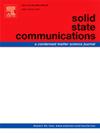Investigation of spin-polarized electronic states of CBVN defects in h-BN monolayers
IF 2.1
4区 物理与天体物理
Q3 PHYSICS, CONDENSED MATTER
引用次数: 0
Abstract
This study presents an investigation of the electronic properties of the nitrogen-vacancy adjacent to carbon substitution of boron (CBVN) color center in hexagonal boron nitride (h-BN) monolayers, utilizing first-principles density functional theory (DFT) calculations. To understand the effects of this defect on the electronic structure, density of states (DOS), partial DOS (PDOS) behaviors, electron and spin distributions, and charge analysis methods were used. The PDOS analysis provides essential information about the defect-related states and contributions of orbitals from different atoms to each state. Comparisons of charge distributions obtained via Yu-Trinkle, Bader, and Voronoi methods show the reliability of atomic-basin-centered approaches such as Yu-Trinkle and Bader are suggested to be consistent methods for analyzing localized defects. These results contribute to the fundamental understanding of defect engineering in h-BN and can suggest pathways for developing emerging materials for quantum information processing and nanophotonics.
h-BN单层中CBVN缺陷的自旋极化电子态研究
本研究利用第一性原理密度泛函理论(DFT)计算研究了六方氮化硼(h-BN)单层中硼碳取代(CBVN)色中心附近的氮空位的电子性质。为了了解这一缺陷对电子结构的影响,使用了态密度(DOS)、部分DOS (PDOS)行为、电子和自旋分布以及电荷分析方法。PDOS分析提供了与缺陷相关的状态和不同原子对每个状态的轨道贡献的基本信息。通过Yu-Trinkle、Bader和Voronoi方法得到的电荷分布的比较表明,以原子盆为中心的方法(如Yu-Trinkle和Bader)是分析局部缺陷的一致方法。这些结果有助于对h-BN缺陷工程的基本理解,并可以为开发用于量子信息处理和纳米光子学的新兴材料提供途径。
本文章由计算机程序翻译,如有差异,请以英文原文为准。
求助全文
约1分钟内获得全文
求助全文
来源期刊

Solid State Communications
物理-物理:凝聚态物理
CiteScore
3.40
自引率
4.80%
发文量
287
审稿时长
51 days
期刊介绍:
Solid State Communications is an international medium for the publication of short communications and original research articles on significant developments in condensed matter science, giving scientists immediate access to important, recently completed work. The journal publishes original experimental and theoretical research on the physical and chemical properties of solids and other condensed systems and also on their preparation. The submission of manuscripts reporting research on the basic physics of materials science and devices, as well as of state-of-the-art microstructures and nanostructures, is encouraged.
A coherent quantitative treatment emphasizing new physics is expected rather than a simple accumulation of experimental data. Consistent with these aims, the short communications should be kept concise and short, usually not longer than six printed pages. The number of figures and tables should also be kept to a minimum. Solid State Communications now also welcomes original research articles without length restrictions.
The Fast-Track section of Solid State Communications is the venue for very rapid publication of short communications on significant developments in condensed matter science. The goal is to offer the broad condensed matter community quick and immediate access to publish recently completed papers in research areas that are rapidly evolving and in which there are developments with great potential impact.
 求助内容:
求助内容: 应助结果提醒方式:
应助结果提醒方式:


